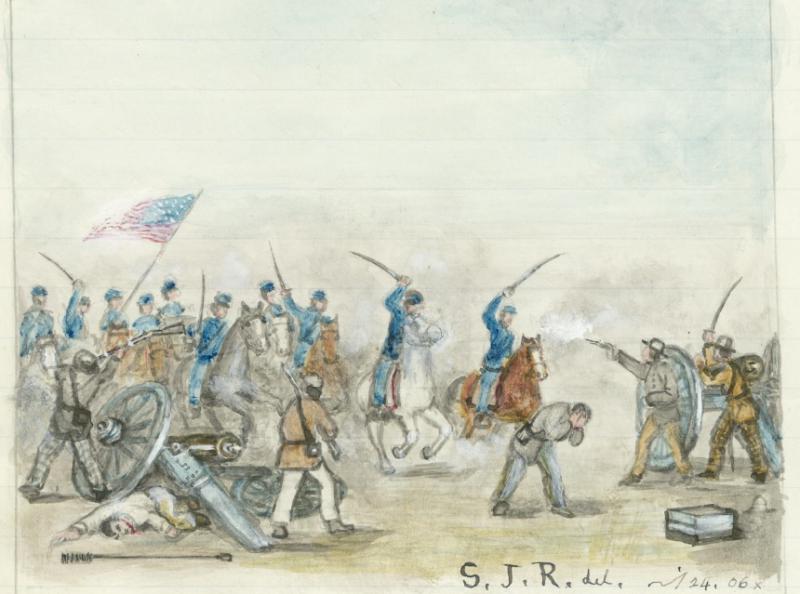By Terry Beckenbaugh, U. S. Air Force Command and Staff College
Event Summary:
- Date: October 25, 1864
- Location: Near Mine Creek in Linn County, Kansas
- Adversaries: Union Army vs. Army of Missouri
- Size of Forces: Approx. 2,600 Union troops vs. approx. 7,000 Army of Missouri troops
- Casualties: Approx. 100 Union troops killed; approx. 1,200 Army of Missouri troops killed
- Result: Union victory
The Battle of Mine Creek, fought on October 25, 1864, was a devastating defeat for Major General Sterling Price’s Confederate Army of Missouri. Price had a large wagon train full of supplies, ammunition, and plunder taken during his failed Missouri Expedition, and he hoped to shepherd it safely to Arkansas or Texas. However, federal cavalry caught up with Price and turned the withdrawal into a rout as his army retreated south from Kansas City two days after its defeat at the Battle of Westport.
When the Army of Missouri entered its namesake state in September, hopes were high for taking Missouri for the Confederacy. Things went awry quickly. The first significant combat was the Battle of Pilot Knob on September 27, when the rebels captured Fort Davidson only after taking heavy casualties.
Next, Price turned away from St. Louis in early October because it was too heavily fortified. Moving west, the Confederates failed to take the capital, Jefferson City. The Army of Missouri then continued west toward Kansas and Fort Leavenworth. By the time the Confederates gave up trying to capture Jefferson City on October 8, the federal noose was beginning to close around the Army of Missouri’s neck. Troops from the Department of the Missouri, led by the Provisional Cavalry Division commanded by Major General Alfred Pleasonton, pursued Price. Meanwhile the Army of the Border, commanded by Major General Samuel Ryan Curtis, formed to the west. At Westport, the federals caught up to Price.
If the defeat at Westport ended the dream of a Confederate Missouri, Mine Creek was the start of a nightmare for the Army of Missouri.
The rebels were defeated and barely escaped at the Battle of Westport on October 23. While the federal Army of the Border held firm to the west, Pleasonton’s Provisional Cavalry Division hit the Confederates from the east, forcing the retreat to the south. The federals caught Price’s rearguard on October 25 and fought three separate battles throughout the day: the Battle of the Marais des Cygnes River at daybreak, the Battle of Mine Creek before noon, and the Battle of the Marmiton River in the late afternoon. All three were federal victories, but Mine Creek was the most significant.
If the defeat at Westport ended the dream of a Confederate Missouri, Mine Creek was the start of a nightmare for the Army of Missouri. After hitting the rebel rear guard in the morning at the Marais des Cygnes River near Trading Post (in Linn County, Kansas) and capturing over 100 prisoners and two artillery pieces, the federals resumed their pursuit. Two brigades of federal cavalry, commanded by Colonel Frederick Benteen (the same Benteen who later rode with Custer) and Colonel John F. Phillips, once again made contact with Price’s rear guard as it crossed Mine Creek. Phillips and Benteen had roughly 2,600 men with which to attack the Confederate force of Major Generals James Fagan and John S. Marmaduke’s divisions of approximately 7,000 men total.
Despite the odds, Benteen ordered a charge. Benteen’s brigade stopped about 200 yards in front of the rebel line, but Major Abial Pierce of the 4th Iowa cavalry rode in front of his men to get the charge going again. Fagan and Marmaduke did not order their men to fight dismounted, and because many were armed with muzzle-loading rifle muskets, they could only get off one shot. When the charging federals hit the rebel line, it disintegrated. The rout was made worse by the Confederates desperately trying to get across Mine Creek, creating a massive traffic jam. The rebels took over 1,200 casualties, including between 200-300 men who were murdered by the federals in retaliation for atrocities committed earlier in Price’s campaign. Fagan and Marmaduke were also captured, and the Army of Missouri struggled on despite the loss in men and much of the wagon train.
Both forces were exhausted by the constant fighting during the day.
The federals caught up to the Army of Missouri again later in the afternoon, and there was a smaller battle as the Confederates crossed the Marmiton River. Although a federal victory, both forces were exhausted by the constant fighting during the day. The Army of Missouri never regained its strength after Mine Creek.
The Battle of Mine Creek was one of the biggest cavalry engagements of the Civil War. The charge by the two federal brigades was something rarely seen during the conflict, and it was one of the last of its kind as technology and improved firepower made that kind of cavalry charge obsolete. The defeat at Mine Creek sapped the Army of Missouri of much of its manpower and supplies. From this point on, their main goal was simply to escape. That too would be difficult, and the small remnants that made it back into Texas and Arkansas were a far cry from the confident force that moved into Missouri several months earlier.
Suggested Reading:
Buresh, Lumir F. October 25th and the Battle of Mine Creek. Kansas City, MO: The Lowell Press, 1977.
Monnett, Howard N. Action Before Westport 1864. Boulder, Colorado: University Press of Colorado, 1995, revised edition. Originally published in 1964.
Stalnaker, Jeffrey D. The Battle of Mine Creek: The Crushing End of the Missouri Campaign. Charleston, SC: The History Press, 2011.
Cite This Page:
Beckenbaugh, Terry. "Battle of Mine Creek" Civil War on the Western Border: The Missouri-Kansas Conflict, 1854-1865. The Kansas City Public Library. Accessed Friday, April 26, 2024 - 17:07 at https://civilwaronthewesternborder.org/encyclopedia/battle-mine-creek


